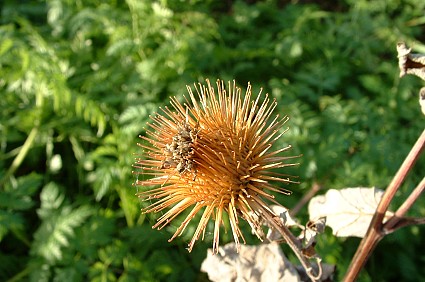7 Edible Weeds
 Along with gardening season comes the battle with weeds. They compete for soil nutrients, sunlight, and they enjoy disturbed soil. But did you know that many common garden weeds are actually edible? In some cases, they're quite nutritious and delicious.
Along with gardening season comes the battle with weeds. They compete for soil nutrients, sunlight, and they enjoy disturbed soil. But did you know that many common garden weeds are actually edible? In some cases, they're quite nutritious and delicious.
The following is a list of seven common edible weeds. At least one of them, and, depending on where in North America you live, perhaps a handful of them may be growing in your yard right now.
While it's exciting to find free food and medicinal plants growing in your yard, be sure you positively identify your plants before eating. If you're not sure, contact your local university extension.

Yellow Dock/Burdock: The long dock taproot is used as a food and as a medicinal herb. It is a good source of dietary fiber and certain minerals, including calcium and potassium. While it was occasionally sold at small health food stores, dock has started appearing in mainstream groceries like Whole Foods, and it may be growing in your yard right now!

Lamb's Quarter: The leaves of lamb's quarter, also known as goosefoot, have a pleasant nutty flavor and are excellent added fresh to lettuce salads, or cooked and used as a replacement for spinach. Being related to amaranth and quinoa, lamb's quarter seeds are also edible and a good source of protein, vitamin A and other vitamins and minerals.

Dandelion: Everyone knows what a dandelion looks like, and that dandelion greens are sold as a high-end salad green at groceries and fine restaurants, but people do not often put the two together. Yes, this humble sidewalk-crack weed is edible. The leaves taste slightly bitter and are high in iron. Also, if you can gather enough dandelion flowers, recipes abound for dandelion wine.

Nettles: Nettles are often one of the least welcome garden weeds because of their sting. However, the leaves may be harvested, cooked, and used as you would use spinach. They are particularly good cooked in soup. The leaves can also be dried for preservation. Nettle provides vitamin C, protein and many minerals, including iron. Nettle can also be used as a vegetarian source of rennet for cheese making.

Amaranth: Also known as pigweed when it grows as a weed, amaranth is in the same family as quinoa. It was historically one of the staple foods of the Incas and is high in vitamins and minerals, including vitamins A, K, B6, and calcium and iron, and the seeds are a good source of protein. Its leaves can be cooked and its seeds can be harvested and cooked the same as quinoa. The mature root is also edible.

Plantain: Not to be confused with the banana, plantain the weed, like dandelions, are a humble sidewalk weed. There are broad and thin-leafed varieties. Their young leaves can be used fresh, and their mature leaves should be cooked. However, they are especially known for their medicinal healing qualities, for instance as a poultice on insect bites, rashes or cuts. They are said to have many healing qualities including helping with coughs and bronchitis.

Purslane: Purslane is a succulent and its leaves, stems, and flowers can be eaten fresh or cooked and tastes like spinach. It is a good source of vitamins, minerals, and antioxidants and is high in omega-3 fatty acids. It can be found growing in all 50 states.
Looking for a Pro? Call us (866) 441-6648

Landscaping Average Costs
Landscapers Experiences

Rock Landscaping Adds Curb Appeal To An Arizona Home

Concrete Patio Is The Finishing Touch For An Artist's Studio



